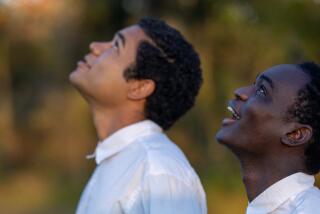He really projects his love of film
- Share via
Jess Daily
Chief projectionist at the James Bridges Theater at UCLA; also works as a projectionist at the Academy of Motion Picture Arts and Sciences and at private homes.
The job: “I am responsible for the operation of the [Bridges] theater in general and specifically the projection booth -- all the technical things required to operate the theater -- the screen, the curtain, the sound system and anything in the projection booth, the projectors, the film inspection equipment. I have a great staff that helps me.”
Reels to reel: “We have four film projectors -- two 16-millimeter projectors and two projectors that can project 35- or 70-millimeter films. We have a variety of video projection equipment, which has been more prominent in the past few years -- DVDs and digital videotape.”
Fire watch: “We’re one of the few places in the world that can still legally project nitrate film, which we do frequently because our archive has a lot of it. Nitrate film is extremely flammable. It can burn underwater. It cannot be extinguished, and it can spontaneously ignite. We have a list of regulations enforced upon us by the fire marshal. Each nitrate show requires two projectionists, so one can be next to each projector that is used in the show.
“The equipment itself is all enclosed so if there is a fire, hopefully it won’t spread. In our booth, we have a very large projection window that was too large to meet the code for a nitrate projection booth, so we have a fire door that comes down in front of us for a nitrate show. In that door are smaller portholes with fire shutters over them that will fall in case of a fire. If anyone saw ‘Cinema Paradiso,’ you got an example of what a nitrate fire can do.”
Problem solving: “We inspect every foot of film that we run, no exceptions, and so we hopefully prevent any problems....We wind the film through our fingers and look for torn perforations ... make sure all the film is there, all the reels are in the right order and make sure the changeovers work correctly. We still do changeovers where we change reels over 15 to 20 minutes. We have to make sure those cues are correct.”
Moonlighting: “I have a business on the side where I run films in private homes. Sometimes I am involved in the installation of screening room, but most of the time I am operating and maintaining the equipment. Most people don’t know of those types of operations because usually they are in celebrities’ homes.
“My first job [at a home], I was in the projection booth -- I won’t say whose house this is -- and I looked out there and there was this really heavy guy walking around smoking a cigar. It was Orson Welles! I almost fainted.”
Background: “When I was about 20 years old I saw Sergio Leone’s ‘The Good, the Bad and the Ugly.’ This was back in Alabama, where I was from. I always had an interest in photography and movies. I worked at the local TV station, where I did everything from cameraman to director. I saw that film and decided I wanted to be in the film business because it was an amazing film. So I came to UCLA to go to graduate school in film production. During my stay there as a student, this job opened up and I had some experience and I applied for it. I got the job, and I stayed. And I love it.”
Digital versus film: “I think digital is pretty exciting.... I don’t think film will ever go away completely. You can take a piece of a 35-millimeter film and show it anywhere in the world. You really can’t do that with any other media, at least not yet.
“Plus the complexity of digital is much more so than film. We did a digital demonstration the other night for the American Society of Cinematographers, and I think it took the guys five hours to set up their projector and it took us five minutes to set up the film projector. It is very complicated. It’s a computer. Film is what I like to call bulletproof -- digital is certainly not. The way people thought that television would replace movies or videotape would replace film, that never happened, and I don’t think it’s going to happen this time.”
Off hours: “I got married later in life, and I have young kids. I am sort of beginning to take them to the movies now and then. I generally don’t like to go to theaters because I don’t like the presentations because they are all automated. So I will take them to UCLA or the academy or sometimes to one of my private homes to see it properly. I have my own screening room at home that runs films -- not video. I am just not there yet.”
Resides: Culver City
Age: 58
Union or guild: “I am a member of two: the University Professional and Technical Employees, and I am a member of the IATSE Local 150, which is the projectionist union.”
-- Susan King
More to Read
The biggest entertainment stories
Get our big stories about Hollywood, film, television, music, arts, culture and more right in your inbox as soon as they publish.
You may occasionally receive promotional content from the Los Angeles Times.











